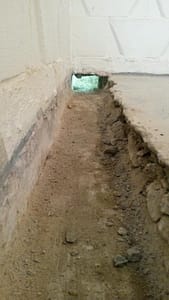Things about Best Basement Waterproofing
Things about Best Basement Waterproofing
Blog Article
Best Basement Waterproofing - The Facts
Table of ContentsEverything about Best Basement WaterproofingThe smart Trick of Best Basement Waterproofing That Nobody is DiscussingNot known Factual Statements About Best Basement Waterproofing Best Basement Waterproofing - TruthsBest Basement Waterproofing Can Be Fun For Anyone
AdvantaClean's qualified specialists and technicians will certainly situate the water resource. If wall surface or slab fractures are existing, we will certainly inject polyurethane and epoxies right into the fractures and secure the concession, preventing more dampness from entering.
If there's condensation on the outside of the foil, you have high humidity in your cellar. If the aluminum foil has condensation on the inside surface area (next to the wall surface), the dirt around your home may be naturally damp from a high water table or poor dirt drain.
You can waterproof just your indoor walls, which might resolve the trouble. Once they dry, they adhere permanently to concrete and stonework wall surfaces.
An Unbiased View of Best Basement Waterproofing
Swirl the brush at the last of application to give the wall an eye-catching, finished look. Concrete waterproof finishes can not be related to formerly painted surface areas; check the tag. A 5-gallon container expenses concerning $60. Known as densifiers, they are ideal just for wall surfaces that have not been repainted or sealed.
You brush, roll, or spray it on much even more heavily one gallon covers just 75 square feet, not the 300 square feet typical with basic paint. Waterproof paint is great for do it yourself application. You can apply it over painted surface areas, and paint over it once it's treated (one gallon expenses $37).
It can set you back $10,000 to $15,000, depending on the work required. Exterior waterproofing entails digging deep into all around the house to the complete depth of the foundation wall surfaces, then installing a water resistant covering or membrane layer topped by water drainage panels.
We've all been captured in a storm without umbrella or raincoat (Best Basement Waterproofing). And it's always a dish for disaster: whatever's damp, your hairdo is ruined, and things are obtaining moldy. A cellar without waterproofing is kind of like that. Minus the spoiled hairdo component. Your cellar doesn't wish to go via a downpour without appropriate defense equally as long as you do not wish to.
An Unbiased View of Best Basement Waterproofing
If you've done your research, you 'd know there are 2 kinds of waterproofing: interior and outside. It can obtain confusing what they both mean, which one's a much better financial investment, and what will in fact maintain the water out. Do not worry, we assembled this blog site to conveniently specify both techniques for you and go over the advantages and disadvantages of each.
Exterior waterproofing is a waterproofing approach that includes sealing your home from the exterior. The structure walls are after that cleansed, secured, and covered with a water resistant membrane or sealer.
The 10-Minute Rule for Best Basement Waterproofing
It's a much more engaged process that calls for digging up your lawn, which is expensive and time-consuming. Exterior waterproofing includes getting rid of every little thing surrounding the home, consisting of porches, driveways, sidewalks, landscape design, AC units, decks, and so forth. If any one of the job was done incorrectly and water is still entering your basement, there isn't much you can do to fix or fix it.
Inside cellar waterproofing entails waterproofing from the within. Any kind of water that leakages right into your cellar is rerouted prior to it touches your flooring. It's sort of like putting on a raincoat under your garments. It entails 2 points: a water drain track and a redirected here sump pump. It functions by securing the within of your basement walls and floors so company website water that tries to go into is directed out through a sump pump.
It's an efficient approach to water-proof your basement - Best Basement Waterproofing. The drawback of interior cellar waterproofing mainly involves the installment process. This technique needs kept things, furniture, and integrated shelving or closets to be moved from touching the basement wall surfaces. And throughout installation, your basement can't be utilized. The greatest distinction in between the two methods is this: Exterior waterproofing is a preventative option and interior waterproofing is a rehabilitative remedy.
Best Basement Waterproofing Fundamentals Explained
Finally, outside and indoor basement waterproofing are both efficient approaches of shielding your home from water damage. Outside waterproofing produces a barrier that protects against water from entering your home, Visit Your URL while indoor waterproofing redirects water that does enter your home. And it's important to keep in mind that exterior waterproofing is a pricey and disruptive installation procedure when compared to indoor waterproofing.
Whichever technique you choose, make certain you choose a trustworthy and credible contractor for the work. Both methods call for knowledgeable workers to manage the job. If you have any kind of concerns about cellar waterproofing, please connect to us. And if you remain in our service location and have water in your basement, call us for a totally free, no-obligation home examination.
You can fill in our form right here, begin a chat in the bottom right-hand edge, or call us at 1-800-827-0702.
Report this page